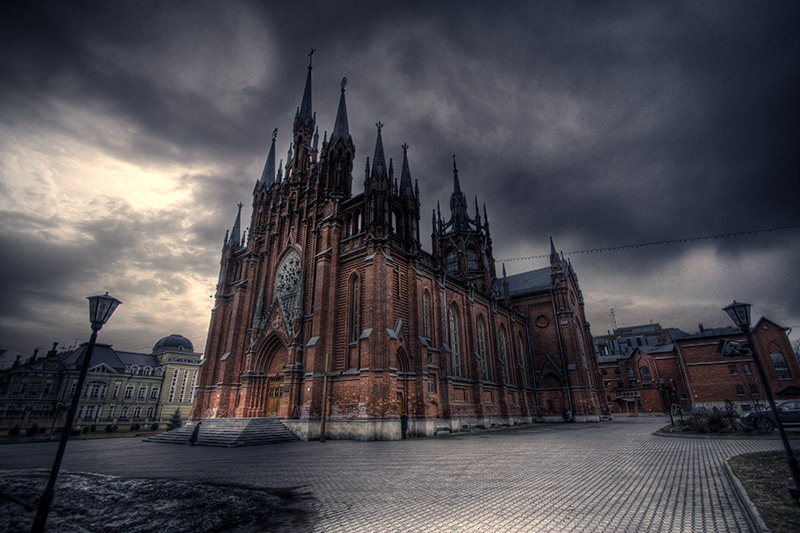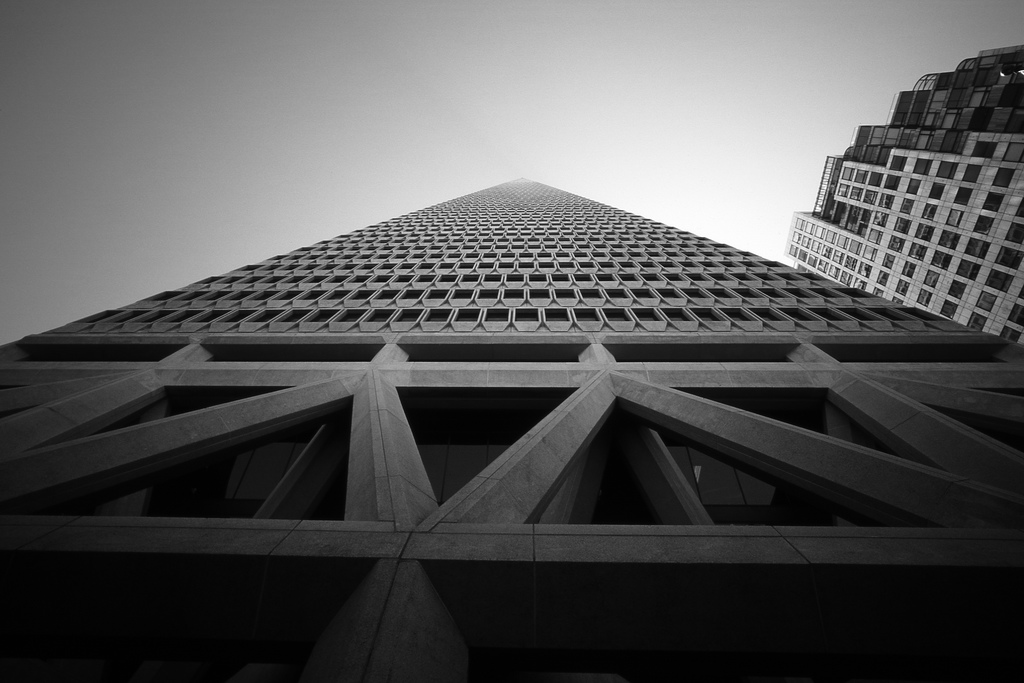There is a long standing convention in photography that if a building has straight sides, then that is how it should look in a photograph. Almost any textbook you pick up about photography (especially architectural photography) will mention and stress this point. Now, while making sure your verticals are vertical is a skill any photographer should have (and one that we will detail in this article), there is an important point to make.
On many occasions, converging verticals in a photograph look damn cool! Look at these dramatic examples:

If you like the dramatic effect of converging verticals then, by all means, continue shooting that way. It's difficult to imagine that the visual appeal of Gotham City or Blade Runner's Los Angeles could be maintained without the occasional converging vertical and similar results can be had in real life by intentionally chasing this visual effect (usually by getting up close with a wide angle lens or tilting the camera to look up). Sometimes the entire visual effect of an image relies on defying some convention or other.
However, if you'd like to straighten up those verticals (and it's probably a skill you should at least have as a photographer, even if you don't plan to use it) then let's look at what you can do. This article is more about shooting skills than trying to dictate what you should do or how you should shoot. Keeping the verticals vertical can be done like this:

Photo by seier+seierStep Back – Getting further away from a building, especially if you're using a wide angle lens, will change the perspective and make the vertical lines straighter. Sometimes this isn't going to be possible (such as in dense cities) but if it's possible, then getting away from the building and shooting from a distance is usually the best option to straighten up the vertical sides of the building.
Level the Camera – Tilting the camera up, especially with a wide angle lens (but with others too), will give you converging verticals. Try to keep the sensor parallel to the buildings. This is as simple as keeping the camera level and resisting that urge to tilt it higher. Again, this isn't always possible, but it's something to keep in mind if you want straighter vertical lines.
Get Higher – Following on from the last point about keeping your sensor parallel to the face of the building you are photographing, sometimes one of the easiest (or only) ways to do that is to get a higher vantage point – often by taking the photograph from another building so that you can get high off the ground.
Think Foregrounds – If you are using a wide angle lens, and cannot get further away or climb a nearby building, then have a look around for an interesting foreground. If you can find something of interest to include in the foreground of your shot, then it will look as if the composition is intentional and you will still have nice, straight verticals and an interesting foreground to boot.
Get a Shift Lens – A shift lens basically allows you to control the mid point or center line of an image so (for our purposes) you can fit more in without the problem of converging verticals. You can read more about the wonders of shift lens here, but if you're doing a lot of architectural shooting it's a piece of equipment that you should seriously consider.
Get Your Post Production Skills Kicking – It is quite possible to use many different pieces of photography post-production software to straighten up your verticals. As always, it's probably best to do as much as you can “in-camera” while you are shooting, but sometimes, if that's just not possible, then you will need to go with the software option. There is a nice little tutorial on straightening verticals in Photoshop that you can read here and one for GIMP users here.
This is basically a process of elimination. If one strategy doesn't work, then move onto the next (or combine them) and you will start to see that the vertical lines get closer to straight. As we mentioned at the beginning, if you're looking for dramatic converging verticals to add impact to your architectural photography then you may not even use these techniques, but it's nice to have the skills to shoot straight verticals if you ever change your mind.









16 Comments
Great advice to photographers and lovely examples.
What you did not mention is that when converging verticals as in the examples above, the convergence should be exaggerated, not very slightly out, ie obvious it was deliberate.
And, as with your examples, that placing the building / converged subject matter in the centre of the frame makes for the strongest composition.
A rule that came in as photography became more able to aid early technical drawing for architectural draughtsmen. Like all good rules, it’s occasionally asking to be broken.
Of course, those without a 5×4 could use GIMP or Photoshop to correct those verticals where required or desired …
Nice pics BTW … 😎
One can also use the free utility called ShiftN to correct distortion. See:
Great article. This totally applies to my personal style of photography and it sure is great to come here and read a fantastic article like this on the topic.
Hey guys…i just saw a tweet from Scott Kelby…
“@ScottKelby: Best article on photographing buildings I’ve read in a while. It will make some people mad, but it made me very happy!”
For those of you that don’t know who he is (and I’m sure that’s not many of you), here’s a link to his wiki page: https://en.wikipedia.org/wiki/Scott_Kelby
Cheers to you Lightstalking!
Very informative article, photographs are stimulating to the eye – super album! Thanks for posting.
https://img.wylio.com/flickr/3894/500/2361731216
Done well, converging verticals can make a high-impact image. I agree with Hamish; it has to look intentional.
You can also make corrections in Adobe Lightroom 3. In the Develop module go to Lens Corrections, Manual and use the Vertical slider.
Another fun technique for high-impact is to intentionally tilt the horizon. One of the worst mistakes by snap shooters is not correcting that slight tilt. Maybe a topic for LightStalking to address in the future.
Love the blog, love the tutorials. Hate the hdr.
It’s a good article and I have to say that I agree, converging verticals can add some mood and drama to a shot. I also agree with the comments saying it should look intentional.
All my correction is done in PS, but I would LOVE a shift lens for one reason. Composition. I can correct in PS no problem, but what can be fairly hard, is managing to visualise what the shot will look like once it’s done. Often ending up with excessively wide shots to account for the edit, or not leaving quite enough room for it. Being able to see the image through the viewfinder and compose around it would be amazing.
Image 4. Definitely have to get this editing style into my wedding photography. Great work
What I see too frequently, esp. with shift lenses, is a tendency to overcook the verticals where they almost look wider the higher up the buildings go.
Thankyou, for reminding Rules are allowed to be broken, or bent, just don’t allow the Wide angle to bend the Verticals, then it can be uncomfortable to look at.
Also thankyou for being about the only teaching site to link to GIMP tutorials, the others assume one can afford PS, yet GIMP is part of my learning process.
Good article, though I break the rule as often as possible.
It adds so much more drama to do an extreme angle.
https://farm9.staticflickr.com/8265/8683892763_018c80bbce_b.jpg
Correcting converging verticals nowadays in post-procesing software (the above tip on Lightroom is one straighforward way) is relatively easy, but be wary of over-correcting, which looks very unsettling. Some argue that a tiny bit of convergence, rather than perfectly vertical verticals (!) is more reassuring to the eye/brain interpretation. I tend to agree.
Good stuff, Rob. It’s always worth taking a closer look at things “everyone knows” because, quite often, things have changed since the day when rule was written.
This is something I’ve encountered quite a bit, since I like architectural shots. And people are entitled to their opinions, but so am I, and my opinion is that software solutions are of the “better than nothing” variety. I own several of the best, including Photoshop and DxO Optics, and, while they can do some pretty incredible things (especially DxO), the end result is not the same as getting the shot right in the first place. And if you do it as an afterthought, rather than planning ahead, the results will probably NOT be “better than nothing”. There’s a lot more I could say on that subject, but no one asked me, so I won’t.
What I do want to add is that, even if you’re not going for the exaggerated look, you still may not want to completely take out all the convergence when dealing with tall buildings. Why? Because it looks unnatural, unless you’re able to include the entire building, which is often not the case. We rarely see tall buildings that way, except from a distance, like when viewing a skyline. Even shorter buildings, like the wedge-shaped building in the next to last photo above, can look bizarre if you completely straighten them. It’s just a theory, but I think it’s because we are physically incapable of seeing all of that at once, with our bare eyes; we have to scan across it, and that changes our perspective as we do so. Just something to think about.
My POV is simple. If I can help the image look more natural, or dynamic, I use software. After 40 years of using swings and tilts, being able to make my images look more dynamic and pleasing to the eye is my goal. Also, the client has 85% say in the matter! We are trying to make the architectural presentation, dynamic enough to move the soul of an architect, which may be harder than you imagine!!!